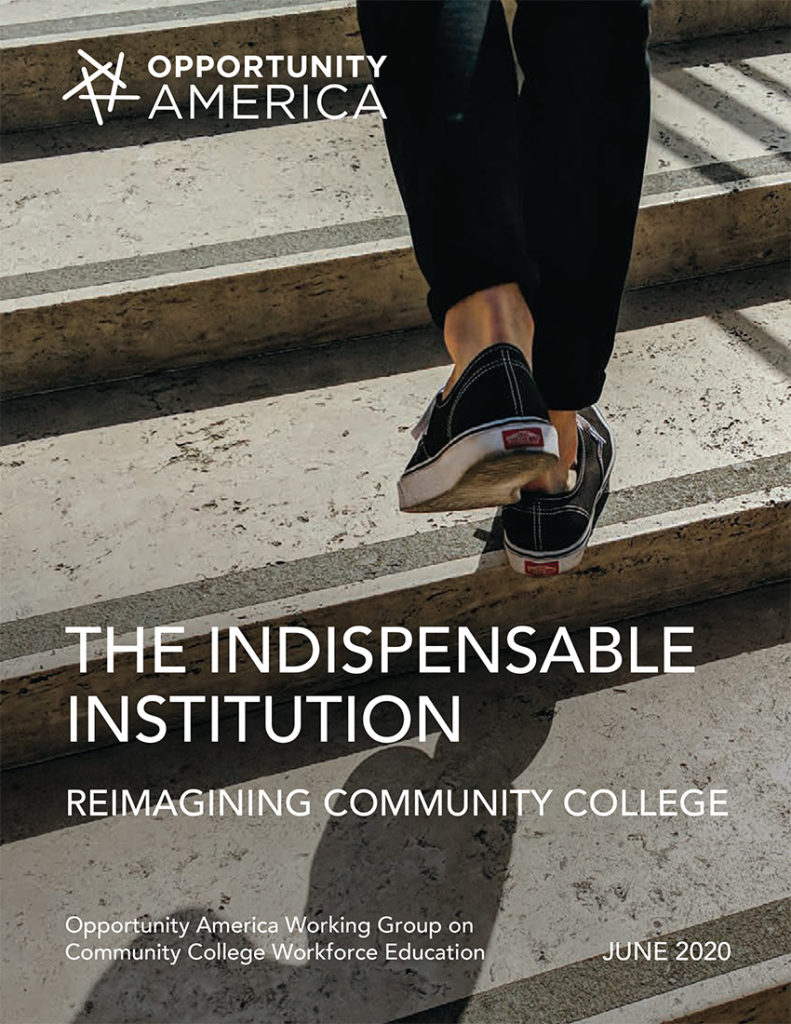A new report calls on community colleges to focus more on workforce development to help displaced workers and others secure available jobs, especially as Americans have lost their jobs due to the pandemic.
“The Indispensable Institution,” a 118-page report by Opportunity America, a Washington-based nonprofit that promotes economic mobility, says community college should be “reimagined” as the pandemic is likely to hasten changes in the workplace.
“Institutions should put workforce skills — career preparation and midcareer upskilling — more at the center of their mission and culture,” the report says. “They should shake off their dependence on four-year colleges and universities — should move beyond a singular focus on preparing students to transfer to a four-year institution. And they should assume the broader responsibilities that come with their new role — including responsibility for the talent pipeline that will be needed for a national economic recovery.”
Several of the recommendations proposed in the report emphasize the strengths of community colleges. For example, it’s first recommendation call on community colleges to be “outward-looking and response to the changing labor market.” It also calls on colleges to teach academic and technical skills, employ work-based learning, engage employers more, integrate credit and noncredit education, and provide more academic and career guidance and supports to students.
The recommendations were crafted from the discussions of a working group that last year examined how two-year colleges could better serve in workforce and economic development. Half of the group’s 22 members are from the community college sector.
The JPMorgan Chase Foundation and Lumina Foundation funded the project.
Outcomes-based funding
The report also says that community college funding should be geared more closely to job placement and wages.
“Unlike traditional academic educators for whom the finish line is graduation, community colleges should be held accountable for what happens after learners leave the college,” it says. “The most important metric by which they should be judged is not completion but employment — high-value employment that results in upward mobility.”
To help them develop structures to foster success, colleges should create a dedicated employer outreach office, add resources for placement staff, develop more robust career services, and focus on better coordination between curriculum and the labor needs of local employers.
Student advising also is crucial.
“Learners need help making sense of labor market information,” the report says. “Some need assistance finding the right mix of technical training and academic instruction. Others need guidance that looks beyond graduation and helps them make choices about future careers.”
It adds that the popular guided pathways reform — which streamlines course options combined with intensive student supports — should be broadened to serve workforce students.
A streamlined system
The report also recommends that community colleges and workforce development systems work more closely to avoid overlapping and duplicative services. State and federal policymakers should encourage colleges and workforce boards to cooperate more closely, integrating and coordinating services, it says.
”What’s needed starts with small, practical steps: colocation, combining staff and sharing labor market information,” according to the report.
It adds that the two institutions could create a single, integrated talent pipeline to fuel economic growth across a region.
The two networks also should be held to the same standards — “perhaps the performance indicators mandated for the workforce system by the Workforce Innovation and Opportunity Act (WIOA).”
New funding models
Meanwhile, policymakers should rethink funding levels for higher education and workforce training, especially community colleges, the report says. Instead of state support based on raw enrollment totals, states should base community college funding in “a vision of regional economic development, and programs that deliver value should be funded more generously.”
It cites one promising approach: tiered full-time-equivalent funding that rewards programs, including noncredit programs that help learners acquire the skills needed to succeed in high-demand, high-paying industries.
In addition, programs that meet their goals should receive more funding than programs that produce poor outcomes, the report says. Outcomes metrics should be aligned with missions, and desirable outcomes should be defined differently depending on the nature of the program, it says.
“Job-focused programs should be rewarded for students’ employment outcomes — post-graduation job placement and improved wages,” it says. “Transfer-oriented programs should be held accountable for transfer rates, but also — a new, higher standard — whether or not transfer fulfills its purpose. Do learners earn a four-year college degree?”
Changes to Pell Grants
The report supports expanding Pell Grant eligibility to short-term training programs that lead to industry-recognized credentials and in-demand skills for the job market. It also encourages Congress to drop the lifetime limit on Pell for students who spend more than an accumulated six years in college.
“Learners moving in and out of lifelong higher education to advance their careers need more flexible funding options,” it says.


